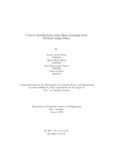| dc.contributor.advisor | Ashraf, Faisal Bin | |
| dc.contributor.author | Monir, Raiyan Janik | |
| dc.contributor.author | Shaon, Shoeb Islam | |
| dc.contributor.author | Noman, Syed Mohammad | |
| dc.contributor.author | Iqbal, Sahariar | |
| dc.date.accessioned | 2022-07-31T05:09:44Z | |
| dc.date.available | 2022-07-31T05:09:44Z | |
| dc.date.copyright | 2022 | |
| dc.date.issued | 2022-01 | |
| dc.identifier.other | ID 19301281 | |
| dc.identifier.other | ID 18101138 | |
| dc.identifier.other | ID 17301125 | |
| dc.identifier.other | ID 18101553 | |
| dc.identifier.uri | http://hdl.handle.net/10361/17044 | |
| dc.description | This thesis is submitted in partial fulfillment of the requirements for the degree of Bachelor of Science in Computer Science, 2022. | en_US |
| dc.description | Cataloged from PDF version of thesis. | |
| dc.description | Includes bibliographical references (page 37). | |
| dc.description.abstract | Cancer is a disease in which some of the body’s cells grow uncontrollably and spread
to other parts of the body. Cancer can start almost anywhere in the human body,
which is made up of trillions of cells. There is usually no cure for this disease and
it is often believed to be untreatable. Breast cancer ranks second among the most
fatal cancers, especially in women. Every year many women suffer and die because
of breast cancer. Early detection of the disease can save many lives. Breast cancer
screening with mammography is essential because it can detect any breast masses
or calcifications early on. Because breast tissue is dense, detecting cancer mass is
difficult, leading radiologists to use machine learning (ML) techniques and artificial
neural networks (ANN) to speed up the detection of cancer. This paper explores the
Mini DDSM dataset, containing 9698 digital mammogram images, which were augmented
and preprocessed, and fed into CNN and MobileNet Architecture with the
aim of detecting normal, benign and cancerous tissues with high accuracy. Therefore,
our aim is to apply the deep neural network based algorithm on a cancer image
dataset to classify cancer and take advantage of image analysis, pattern recognition,
and classification processes, and then validating the image classification outcome
against medical specialist expertise. The main objective of this research is to acquire
a higher accurate outcome on detecting cancer from medical mammography.
Index Terms— Breast cancer detection, neural network, Deep learning, Digital image
processing. | en_US |
| dc.description.statementofresponsibility | Raiyan Janik Monir | |
| dc.description.statementofresponsibility | Shoeb Islam Shaon | |
| dc.description.statementofresponsibility | Syed Mohammad Noman | |
| dc.description.statementofresponsibility | Sahariar Iqbal | |
| dc.format.extent | 37 pages | |
| dc.language.iso | en | en_US |
| dc.publisher | Brac University | en_US |
| dc.rights | Brac University theses are protected by copyright. They may be viewed from this source for any purpose, but reproduction or distribution in any format is prohibited without written permission. | |
| dc.subject | Cancer | en_US |
| dc.subject | Deep learning | en_US |
| dc.subject | Artificial neural networks (ANN) | en_US |
| dc.subject | CNN | en_US |
| dc.subject | Cancer detection | en_US |
| dc.subject | Medical image data | en_US |
| dc.subject.lcsh | Machine learning | |
| dc.subject.lcsh | Cognitive learning theory (Deep learning) | |
| dc.subject.lcsh | Neural networks (Computer science) | |
| dc.subject.lcsh | Image processing -- Digital techniques. | |
| dc.title | Cancer classification using deep learning from medical image data | en_US |
| dc.type | Thesis | en_US |
| dc.contributor.department | Department of Computer Science and Engineering, Brac University | |
| dc.description.degree | B. Computer Science | |

